Strategic Marketing Analysis and Campaign for Cadbury Confectionery
VerifiedAdded on 2022/12/30
|13
|3105
|227
Report
AI Summary
This report provides a detailed analysis of Cadbury's strategic marketing initiatives. It begins with an introduction to strategic marketing and its importance, followed by a market analysis that includes market size, competitor analysis using Porter's five forces, and an assessment of macro and microeconomic factors through PEST analysis. The report also includes customer and stakeholder analysis. Key strategic marketing objectives for a Cadbury campaign are identified, including launching new products and enhancing brand recognition. The campaign strategy, target audience, and general messaging are discussed. Furthermore, the report details strategic implementation using the RACE model, covering planning, reach, action, conversion, and engagement strategies. Finally, the report includes a marketing roll-out plan, key performance indicators, and recommendations for enhancing audience engagement, concluding with a summary of the findings and references.
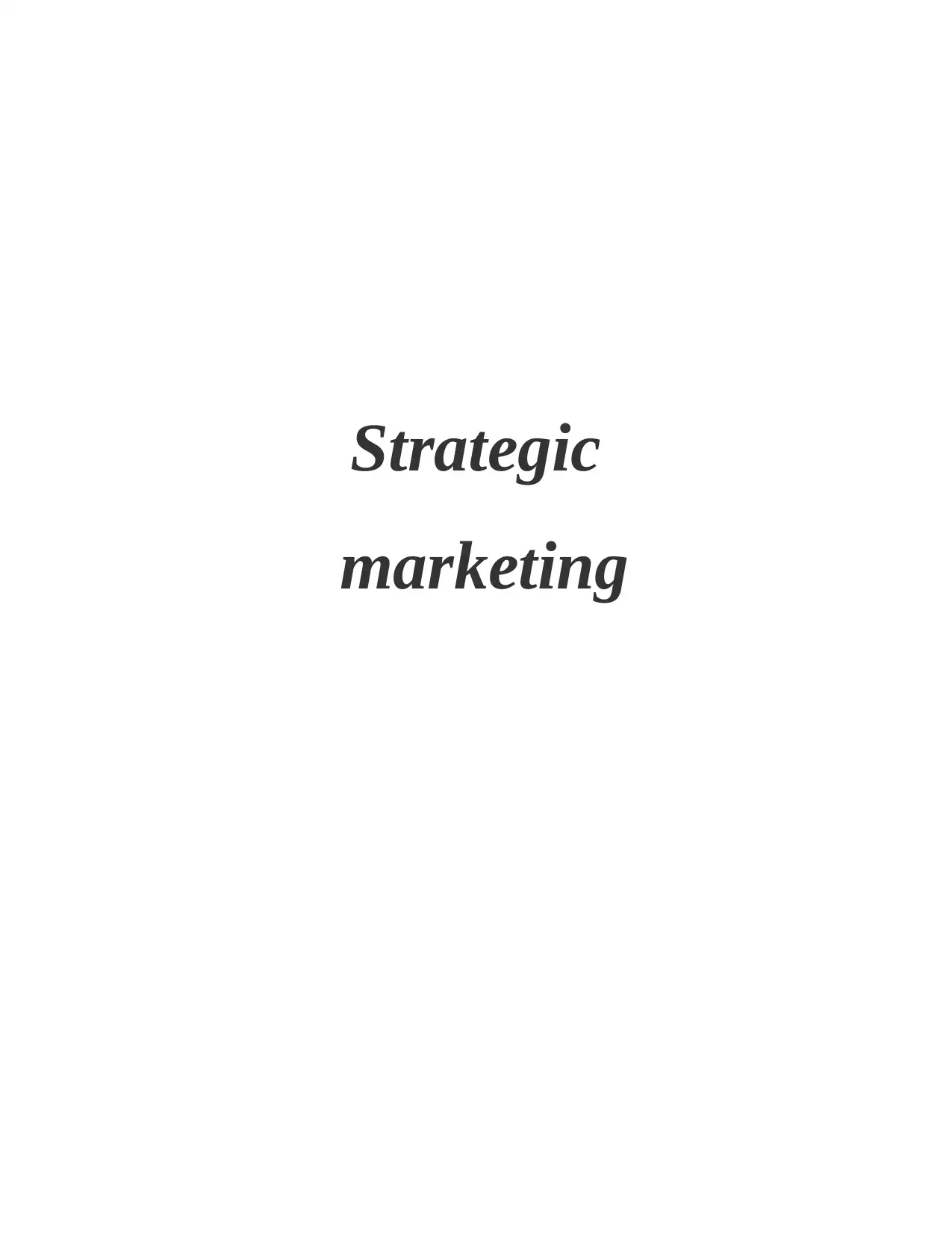
Strategic
marketing
marketing
Paraphrase This Document
Need a fresh take? Get an instant paraphrase of this document with our AI Paraphraser
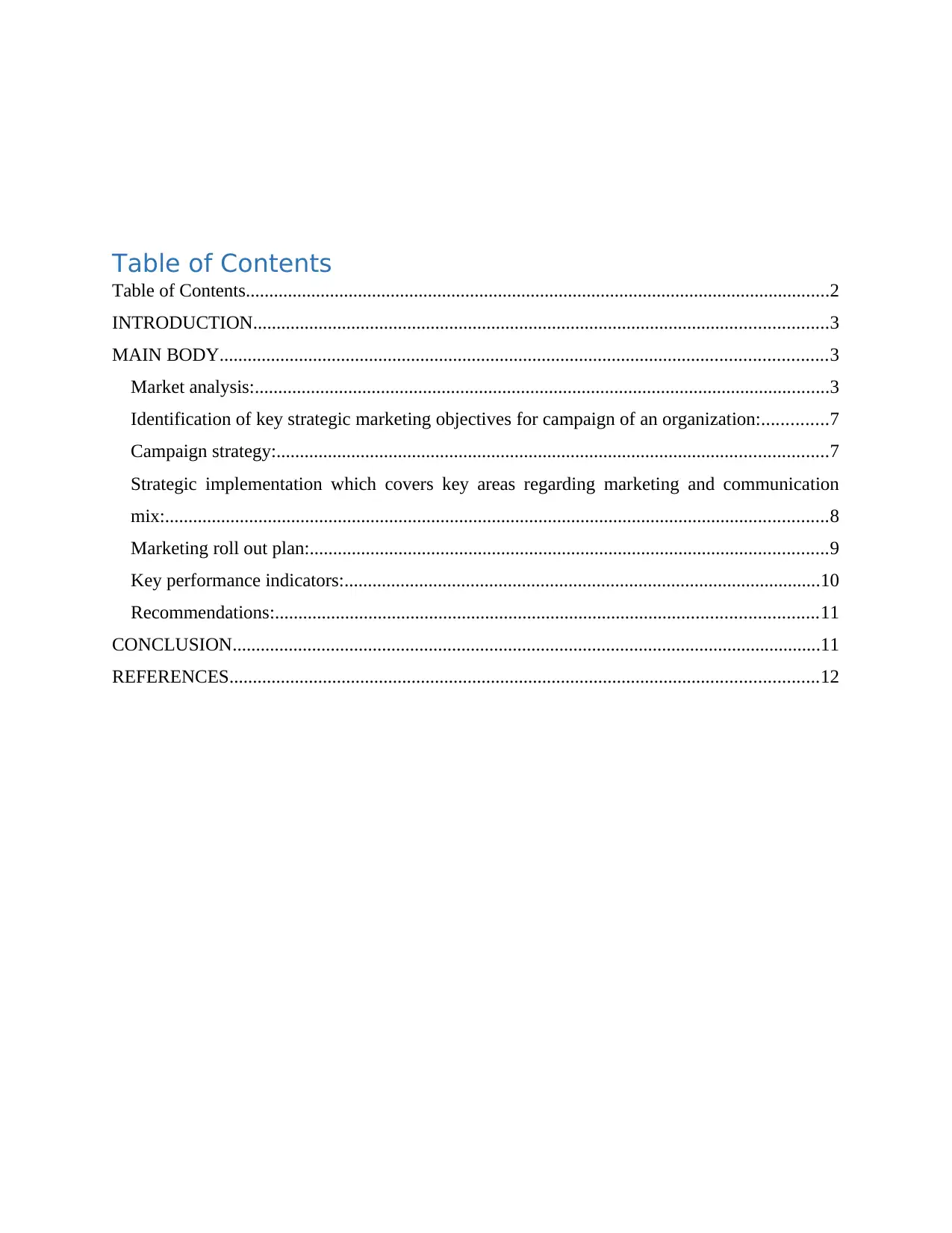
Table of Contents
Table of Contents.............................................................................................................................2
INTRODUCTION...........................................................................................................................3
MAIN BODY..................................................................................................................................3
Market analysis:...........................................................................................................................3
Identification of key strategic marketing objectives for campaign of an organization:..............7
Campaign strategy:......................................................................................................................7
Strategic implementation which covers key areas regarding marketing and communication
mix:..............................................................................................................................................8
Marketing roll out plan:...............................................................................................................9
Key performance indicators:......................................................................................................10
Recommendations:....................................................................................................................11
CONCLUSION..............................................................................................................................11
REFERENCES..............................................................................................................................12
Table of Contents.............................................................................................................................2
INTRODUCTION...........................................................................................................................3
MAIN BODY..................................................................................................................................3
Market analysis:...........................................................................................................................3
Identification of key strategic marketing objectives for campaign of an organization:..............7
Campaign strategy:......................................................................................................................7
Strategic implementation which covers key areas regarding marketing and communication
mix:..............................................................................................................................................8
Marketing roll out plan:...............................................................................................................9
Key performance indicators:......................................................................................................10
Recommendations:....................................................................................................................11
CONCLUSION..............................................................................................................................11
REFERENCES..............................................................................................................................12

⊘ This is a preview!⊘
Do you want full access?
Subscribe today to unlock all pages.

Trusted by 1+ million students worldwide
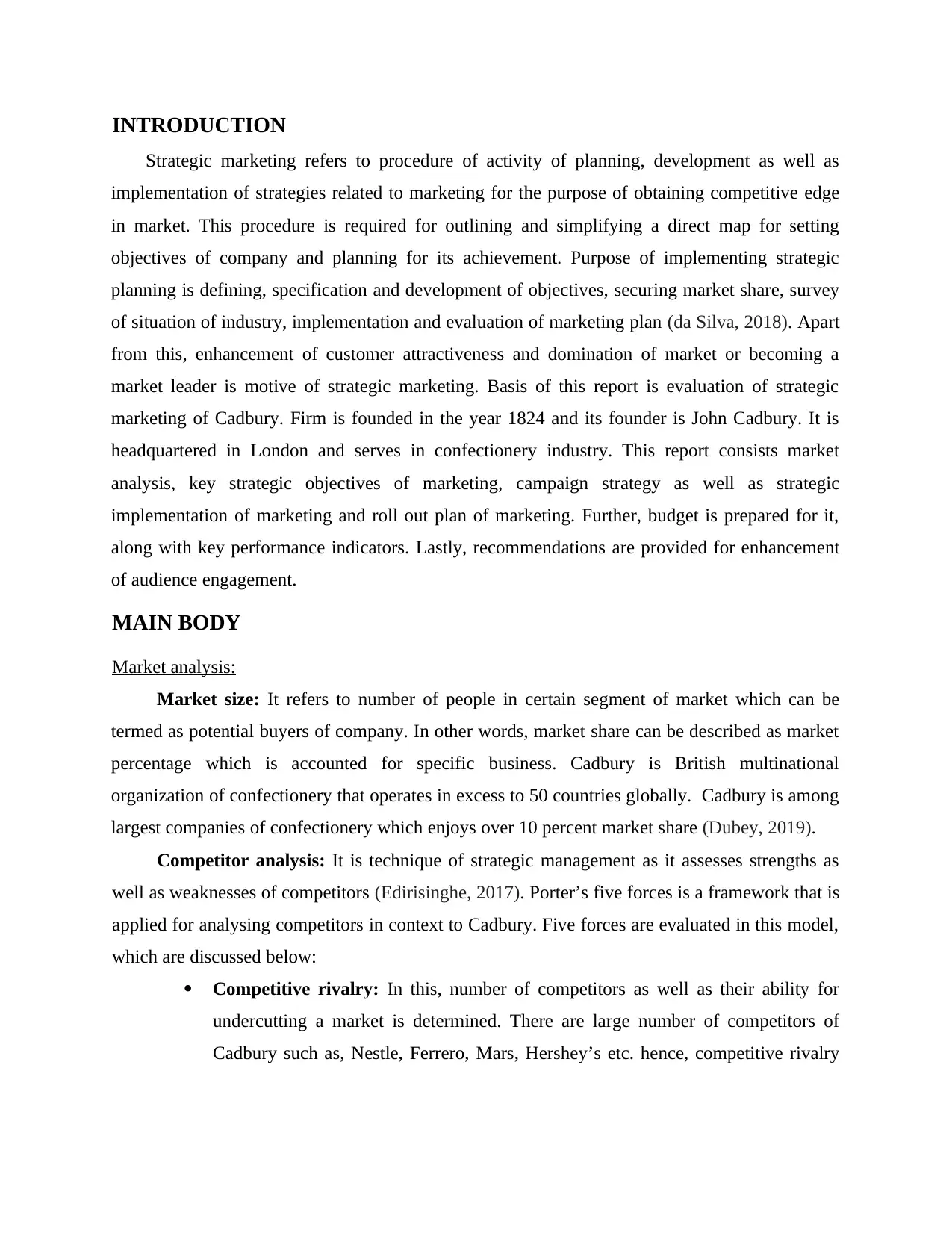
INTRODUCTION
Strategic marketing refers to procedure of activity of planning, development as well as
implementation of strategies related to marketing for the purpose of obtaining competitive edge
in market. This procedure is required for outlining and simplifying a direct map for setting
objectives of company and planning for its achievement. Purpose of implementing strategic
planning is defining, specification and development of objectives, securing market share, survey
of situation of industry, implementation and evaluation of marketing plan (da Silva, 2018). Apart
from this, enhancement of customer attractiveness and domination of market or becoming a
market leader is motive of strategic marketing. Basis of this report is evaluation of strategic
marketing of Cadbury. Firm is founded in the year 1824 and its founder is John Cadbury. It is
headquartered in London and serves in confectionery industry. This report consists market
analysis, key strategic objectives of marketing, campaign strategy as well as strategic
implementation of marketing and roll out plan of marketing. Further, budget is prepared for it,
along with key performance indicators. Lastly, recommendations are provided for enhancement
of audience engagement.
MAIN BODY
Market analysis:
Market size: It refers to number of people in certain segment of market which can be
termed as potential buyers of company. In other words, market share can be described as market
percentage which is accounted for specific business. Cadbury is British multinational
organization of confectionery that operates in excess to 50 countries globally. Cadbury is among
largest companies of confectionery which enjoys over 10 percent market share (Dubey, 2019).
Competitor analysis: It is technique of strategic management as it assesses strengths as
well as weaknesses of competitors (Edirisinghe, 2017). Porter’s five forces is a framework that is
applied for analysing competitors in context to Cadbury. Five forces are evaluated in this model,
which are discussed below:
Competitive rivalry: In this, number of competitors as well as their ability for
undercutting a market is determined. There are large number of competitors of
Cadbury such as, Nestle, Ferrero, Mars, Hershey’s etc. hence, competitive rivalry
Strategic marketing refers to procedure of activity of planning, development as well as
implementation of strategies related to marketing for the purpose of obtaining competitive edge
in market. This procedure is required for outlining and simplifying a direct map for setting
objectives of company and planning for its achievement. Purpose of implementing strategic
planning is defining, specification and development of objectives, securing market share, survey
of situation of industry, implementation and evaluation of marketing plan (da Silva, 2018). Apart
from this, enhancement of customer attractiveness and domination of market or becoming a
market leader is motive of strategic marketing. Basis of this report is evaluation of strategic
marketing of Cadbury. Firm is founded in the year 1824 and its founder is John Cadbury. It is
headquartered in London and serves in confectionery industry. This report consists market
analysis, key strategic objectives of marketing, campaign strategy as well as strategic
implementation of marketing and roll out plan of marketing. Further, budget is prepared for it,
along with key performance indicators. Lastly, recommendations are provided for enhancement
of audience engagement.
MAIN BODY
Market analysis:
Market size: It refers to number of people in certain segment of market which can be
termed as potential buyers of company. In other words, market share can be described as market
percentage which is accounted for specific business. Cadbury is British multinational
organization of confectionery that operates in excess to 50 countries globally. Cadbury is among
largest companies of confectionery which enjoys over 10 percent market share (Dubey, 2019).
Competitor analysis: It is technique of strategic management as it assesses strengths as
well as weaknesses of competitors (Edirisinghe, 2017). Porter’s five forces is a framework that is
applied for analysing competitors in context to Cadbury. Five forces are evaluated in this model,
which are discussed below:
Competitive rivalry: In this, number of competitors as well as their ability for
undercutting a market is determined. There are large number of competitors of
Cadbury such as, Nestle, Ferrero, Mars, Hershey’s etc. hence, competitive rivalry
Paraphrase This Document
Need a fresh take? Get an instant paraphrase of this document with our AI Paraphraser
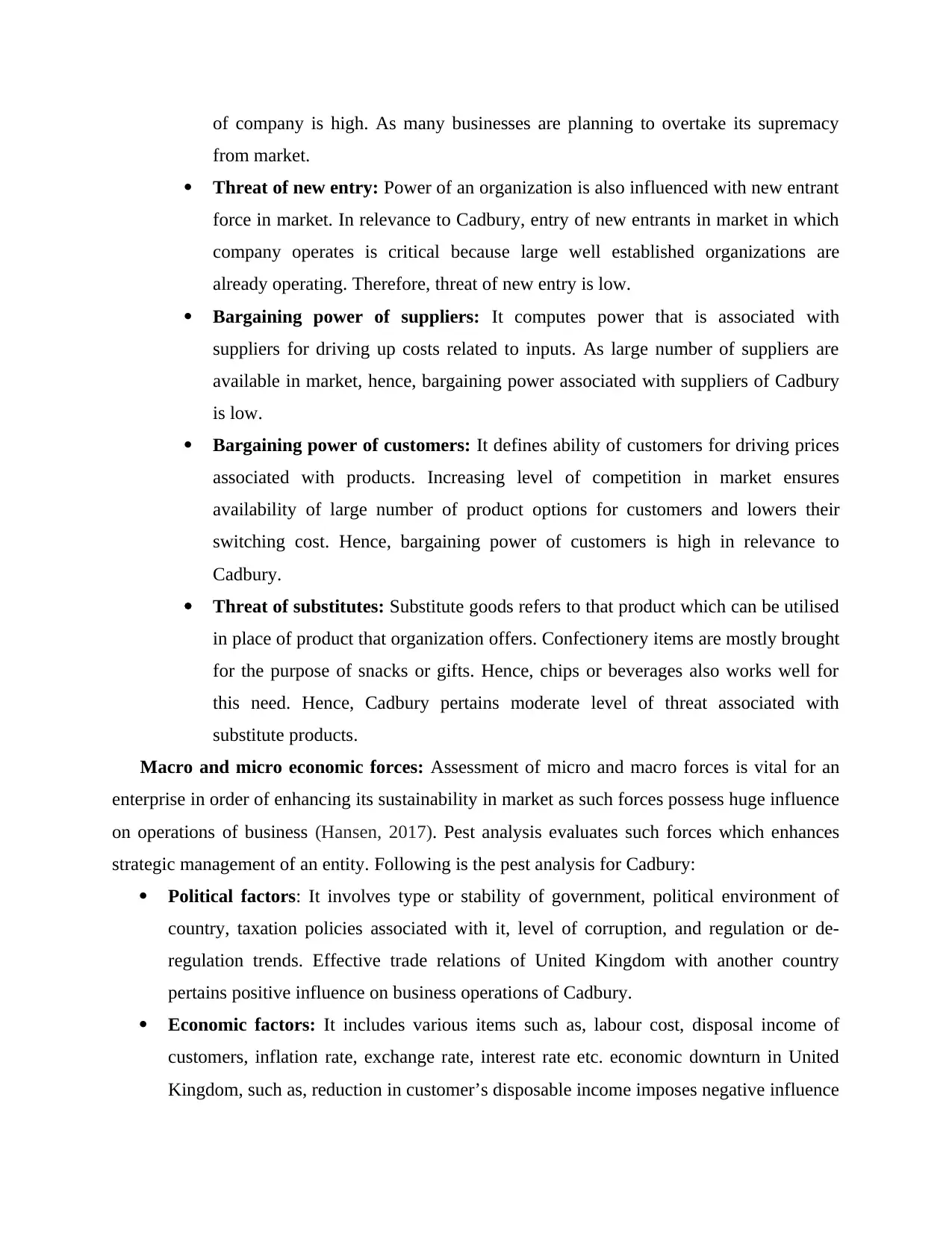
of company is high. As many businesses are planning to overtake its supremacy
from market.
Threat of new entry: Power of an organization is also influenced with new entrant
force in market. In relevance to Cadbury, entry of new entrants in market in which
company operates is critical because large well established organizations are
already operating. Therefore, threat of new entry is low.
Bargaining power of suppliers: It computes power that is associated with
suppliers for driving up costs related to inputs. As large number of suppliers are
available in market, hence, bargaining power associated with suppliers of Cadbury
is low.
Bargaining power of customers: It defines ability of customers for driving prices
associated with products. Increasing level of competition in market ensures
availability of large number of product options for customers and lowers their
switching cost. Hence, bargaining power of customers is high in relevance to
Cadbury.
Threat of substitutes: Substitute goods refers to that product which can be utilised
in place of product that organization offers. Confectionery items are mostly brought
for the purpose of snacks or gifts. Hence, chips or beverages also works well for
this need. Hence, Cadbury pertains moderate level of threat associated with
substitute products.
Macro and micro economic forces: Assessment of micro and macro forces is vital for an
enterprise in order of enhancing its sustainability in market as such forces possess huge influence
on operations of business (Hansen, 2017). Pest analysis evaluates such forces which enhances
strategic management of an entity. Following is the pest analysis for Cadbury:
Political factors: It involves type or stability of government, political environment of
country, taxation policies associated with it, level of corruption, and regulation or de-
regulation trends. Effective trade relations of United Kingdom with another country
pertains positive influence on business operations of Cadbury.
Economic factors: It includes various items such as, labour cost, disposal income of
customers, inflation rate, exchange rate, interest rate etc. economic downturn in United
Kingdom, such as, reduction in customer’s disposable income imposes negative influence
from market.
Threat of new entry: Power of an organization is also influenced with new entrant
force in market. In relevance to Cadbury, entry of new entrants in market in which
company operates is critical because large well established organizations are
already operating. Therefore, threat of new entry is low.
Bargaining power of suppliers: It computes power that is associated with
suppliers for driving up costs related to inputs. As large number of suppliers are
available in market, hence, bargaining power associated with suppliers of Cadbury
is low.
Bargaining power of customers: It defines ability of customers for driving prices
associated with products. Increasing level of competition in market ensures
availability of large number of product options for customers and lowers their
switching cost. Hence, bargaining power of customers is high in relevance to
Cadbury.
Threat of substitutes: Substitute goods refers to that product which can be utilised
in place of product that organization offers. Confectionery items are mostly brought
for the purpose of snacks or gifts. Hence, chips or beverages also works well for
this need. Hence, Cadbury pertains moderate level of threat associated with
substitute products.
Macro and micro economic forces: Assessment of micro and macro forces is vital for an
enterprise in order of enhancing its sustainability in market as such forces possess huge influence
on operations of business (Hansen, 2017). Pest analysis evaluates such forces which enhances
strategic management of an entity. Following is the pest analysis for Cadbury:
Political factors: It involves type or stability of government, political environment of
country, taxation policies associated with it, level of corruption, and regulation or de-
regulation trends. Effective trade relations of United Kingdom with another country
pertains positive influence on business operations of Cadbury.
Economic factors: It includes various items such as, labour cost, disposal income of
customers, inflation rate, exchange rate, interest rate etc. economic downturn in United
Kingdom, such as, reduction in customer’s disposable income imposes negative influence
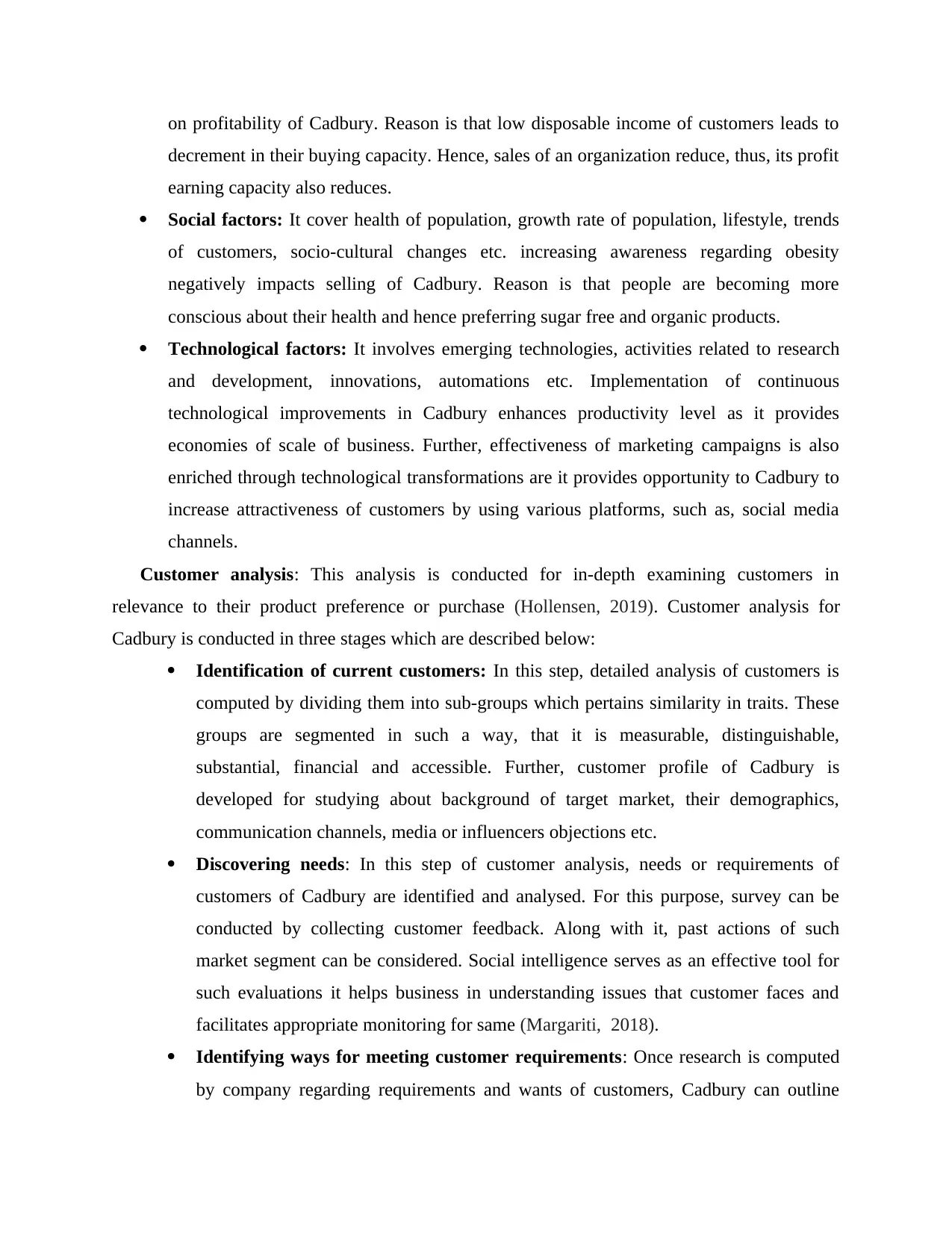
on profitability of Cadbury. Reason is that low disposable income of customers leads to
decrement in their buying capacity. Hence, sales of an organization reduce, thus, its profit
earning capacity also reduces.
Social factors: It cover health of population, growth rate of population, lifestyle, trends
of customers, socio-cultural changes etc. increasing awareness regarding obesity
negatively impacts selling of Cadbury. Reason is that people are becoming more
conscious about their health and hence preferring sugar free and organic products.
Technological factors: It involves emerging technologies, activities related to research
and development, innovations, automations etc. Implementation of continuous
technological improvements in Cadbury enhances productivity level as it provides
economies of scale of business. Further, effectiveness of marketing campaigns is also
enriched through technological transformations are it provides opportunity to Cadbury to
increase attractiveness of customers by using various platforms, such as, social media
channels.
Customer analysis: This analysis is conducted for in-depth examining customers in
relevance to their product preference or purchase (Hollensen, 2019). Customer analysis for
Cadbury is conducted in three stages which are described below:
Identification of current customers: In this step, detailed analysis of customers is
computed by dividing them into sub-groups which pertains similarity in traits. These
groups are segmented in such a way, that it is measurable, distinguishable,
substantial, financial and accessible. Further, customer profile of Cadbury is
developed for studying about background of target market, their demographics,
communication channels, media or influencers objections etc.
Discovering needs: In this step of customer analysis, needs or requirements of
customers of Cadbury are identified and analysed. For this purpose, survey can be
conducted by collecting customer feedback. Along with it, past actions of such
market segment can be considered. Social intelligence serves as an effective tool for
such evaluations it helps business in understanding issues that customer faces and
facilitates appropriate monitoring for same (Margariti, 2018).
Identifying ways for meeting customer requirements: Once research is computed
by company regarding requirements and wants of customers, Cadbury can outline
decrement in their buying capacity. Hence, sales of an organization reduce, thus, its profit
earning capacity also reduces.
Social factors: It cover health of population, growth rate of population, lifestyle, trends
of customers, socio-cultural changes etc. increasing awareness regarding obesity
negatively impacts selling of Cadbury. Reason is that people are becoming more
conscious about their health and hence preferring sugar free and organic products.
Technological factors: It involves emerging technologies, activities related to research
and development, innovations, automations etc. Implementation of continuous
technological improvements in Cadbury enhances productivity level as it provides
economies of scale of business. Further, effectiveness of marketing campaigns is also
enriched through technological transformations are it provides opportunity to Cadbury to
increase attractiveness of customers by using various platforms, such as, social media
channels.
Customer analysis: This analysis is conducted for in-depth examining customers in
relevance to their product preference or purchase (Hollensen, 2019). Customer analysis for
Cadbury is conducted in three stages which are described below:
Identification of current customers: In this step, detailed analysis of customers is
computed by dividing them into sub-groups which pertains similarity in traits. These
groups are segmented in such a way, that it is measurable, distinguishable,
substantial, financial and accessible. Further, customer profile of Cadbury is
developed for studying about background of target market, their demographics,
communication channels, media or influencers objections etc.
Discovering needs: In this step of customer analysis, needs or requirements of
customers of Cadbury are identified and analysed. For this purpose, survey can be
conducted by collecting customer feedback. Along with it, past actions of such
market segment can be considered. Social intelligence serves as an effective tool for
such evaluations it helps business in understanding issues that customer faces and
facilitates appropriate monitoring for same (Margariti, 2018).
Identifying ways for meeting customer requirements: Once research is computed
by company regarding requirements and wants of customers, Cadbury can outline
⊘ This is a preview!⊘
Do you want full access?
Subscribe today to unlock all pages.

Trusted by 1+ million students worldwide
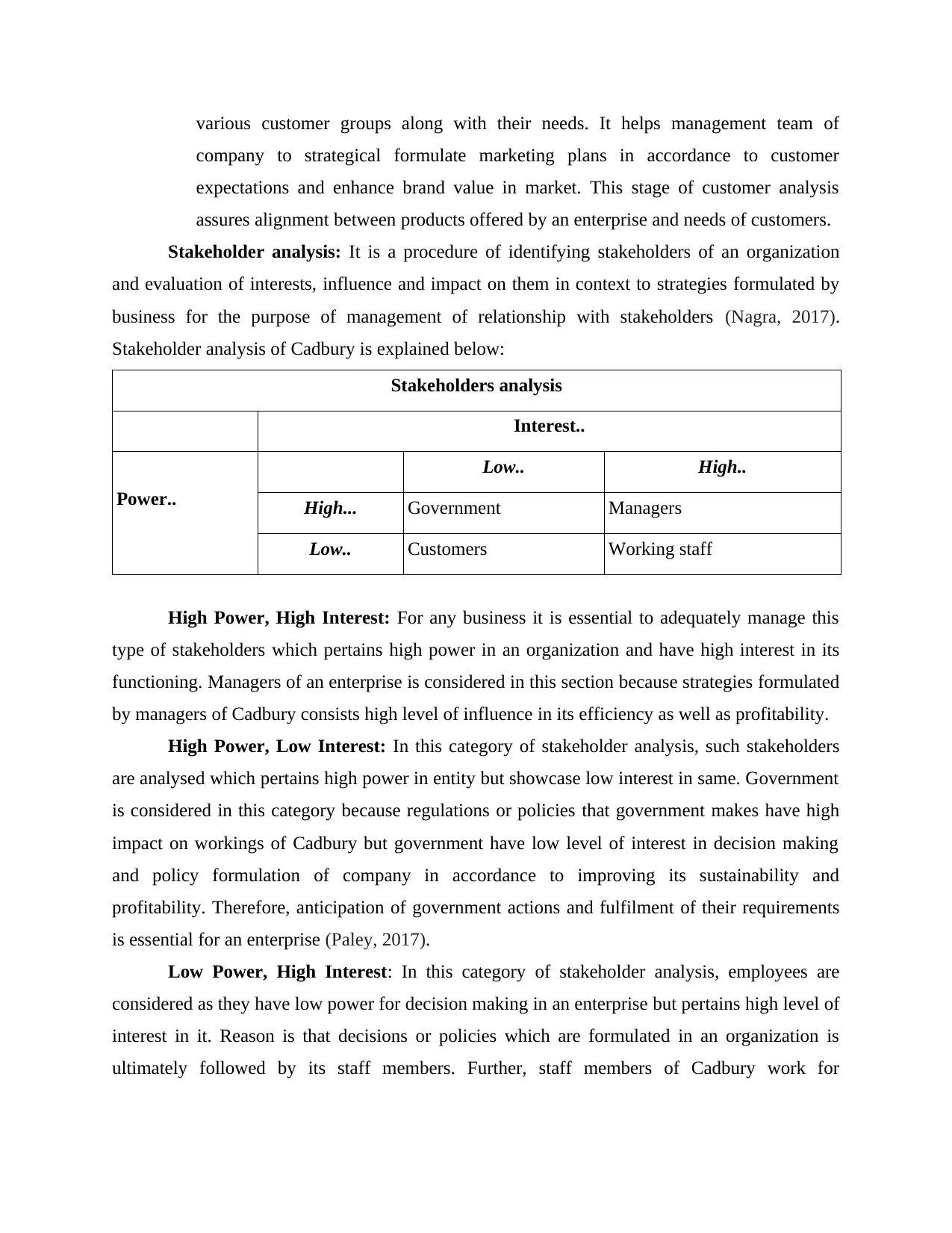
various customer groups along with their needs. It helps management team of
company to strategical formulate marketing plans in accordance to customer
expectations and enhance brand value in market. This stage of customer analysis
assures alignment between products offered by an enterprise and needs of customers.
Stakeholder analysis: It is a procedure of identifying stakeholders of an organization
and evaluation of interests, influence and impact on them in context to strategies formulated by
business for the purpose of management of relationship with stakeholders (Nagra, 2017).
Stakeholder analysis of Cadbury is explained below:
Stakeholders analysis
Interest..
Power..
Low.. High..
High... Government Managers
Low.. Customers Working staff
High Power, High Interest: For any business it is essential to adequately manage this
type of stakeholders which pertains high power in an organization and have high interest in its
functioning. Managers of an enterprise is considered in this section because strategies formulated
by managers of Cadbury consists high level of influence in its efficiency as well as profitability.
High Power, Low Interest: In this category of stakeholder analysis, such stakeholders
are analysed which pertains high power in entity but showcase low interest in same. Government
is considered in this category because regulations or policies that government makes have high
impact on workings of Cadbury but government have low level of interest in decision making
and policy formulation of company in accordance to improving its sustainability and
profitability. Therefore, anticipation of government actions and fulfilment of their requirements
is essential for an enterprise (Paley, 2017).
Low Power, High Interest: In this category of stakeholder analysis, employees are
considered as they have low power for decision making in an enterprise but pertains high level of
interest in it. Reason is that decisions or policies which are formulated in an organization is
ultimately followed by its staff members. Further, staff members of Cadbury work for
company to strategical formulate marketing plans in accordance to customer
expectations and enhance brand value in market. This stage of customer analysis
assures alignment between products offered by an enterprise and needs of customers.
Stakeholder analysis: It is a procedure of identifying stakeholders of an organization
and evaluation of interests, influence and impact on them in context to strategies formulated by
business for the purpose of management of relationship with stakeholders (Nagra, 2017).
Stakeholder analysis of Cadbury is explained below:
Stakeholders analysis
Interest..
Power..
Low.. High..
High... Government Managers
Low.. Customers Working staff
High Power, High Interest: For any business it is essential to adequately manage this
type of stakeholders which pertains high power in an organization and have high interest in its
functioning. Managers of an enterprise is considered in this section because strategies formulated
by managers of Cadbury consists high level of influence in its efficiency as well as profitability.
High Power, Low Interest: In this category of stakeholder analysis, such stakeholders
are analysed which pertains high power in entity but showcase low interest in same. Government
is considered in this category because regulations or policies that government makes have high
impact on workings of Cadbury but government have low level of interest in decision making
and policy formulation of company in accordance to improving its sustainability and
profitability. Therefore, anticipation of government actions and fulfilment of their requirements
is essential for an enterprise (Paley, 2017).
Low Power, High Interest: In this category of stakeholder analysis, employees are
considered as they have low power for decision making in an enterprise but pertains high level of
interest in it. Reason is that decisions or policies which are formulated in an organization is
ultimately followed by its staff members. Further, staff members of Cadbury work for
Paraphrase This Document
Need a fresh take? Get an instant paraphrase of this document with our AI Paraphraser
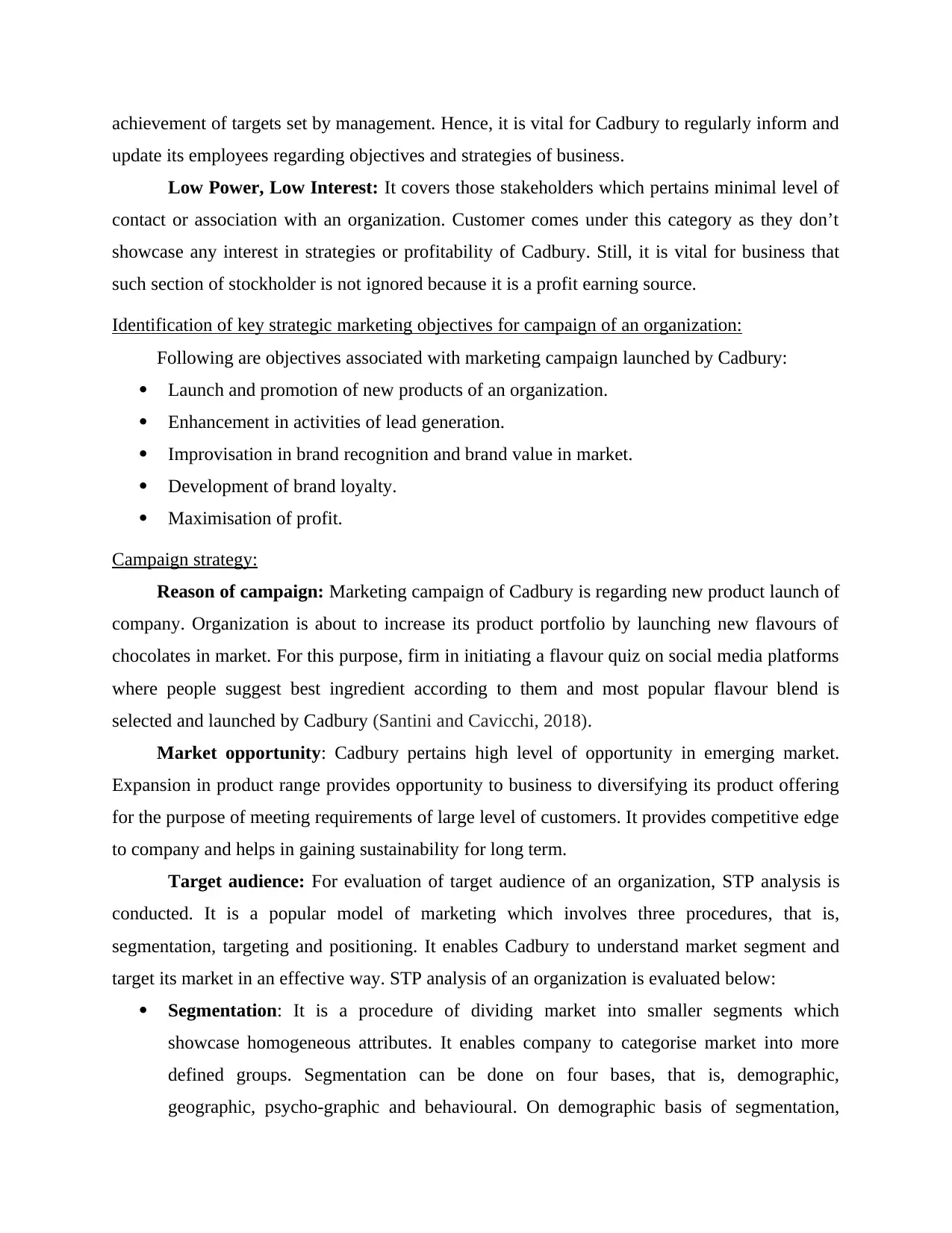
achievement of targets set by management. Hence, it is vital for Cadbury to regularly inform and
update its employees regarding objectives and strategies of business.
Low Power, Low Interest: It covers those stakeholders which pertains minimal level of
contact or association with an organization. Customer comes under this category as they don’t
showcase any interest in strategies or profitability of Cadbury. Still, it is vital for business that
such section of stockholder is not ignored because it is a profit earning source.
Identification of key strategic marketing objectives for campaign of an organization:
Following are objectives associated with marketing campaign launched by Cadbury:
Launch and promotion of new products of an organization.
Enhancement in activities of lead generation.
Improvisation in brand recognition and brand value in market.
Development of brand loyalty.
Maximisation of profit.
Campaign strategy:
Reason of campaign: Marketing campaign of Cadbury is regarding new product launch of
company. Organization is about to increase its product portfolio by launching new flavours of
chocolates in market. For this purpose, firm in initiating a flavour quiz on social media platforms
where people suggest best ingredient according to them and most popular flavour blend is
selected and launched by Cadbury (Santini and Cavicchi, 2018).
Market opportunity: Cadbury pertains high level of opportunity in emerging market.
Expansion in product range provides opportunity to business to diversifying its product offering
for the purpose of meeting requirements of large level of customers. It provides competitive edge
to company and helps in gaining sustainability for long term.
Target audience: For evaluation of target audience of an organization, STP analysis is
conducted. It is a popular model of marketing which involves three procedures, that is,
segmentation, targeting and positioning. It enables Cadbury to understand market segment and
target its market in an effective way. STP analysis of an organization is evaluated below:
Segmentation: It is a procedure of dividing market into smaller segments which
showcase homogeneous attributes. It enables company to categorise market into more
defined groups. Segmentation can be done on four bases, that is, demographic,
geographic, psycho-graphic and behavioural. On demographic basis of segmentation,
update its employees regarding objectives and strategies of business.
Low Power, Low Interest: It covers those stakeholders which pertains minimal level of
contact or association with an organization. Customer comes under this category as they don’t
showcase any interest in strategies or profitability of Cadbury. Still, it is vital for business that
such section of stockholder is not ignored because it is a profit earning source.
Identification of key strategic marketing objectives for campaign of an organization:
Following are objectives associated with marketing campaign launched by Cadbury:
Launch and promotion of new products of an organization.
Enhancement in activities of lead generation.
Improvisation in brand recognition and brand value in market.
Development of brand loyalty.
Maximisation of profit.
Campaign strategy:
Reason of campaign: Marketing campaign of Cadbury is regarding new product launch of
company. Organization is about to increase its product portfolio by launching new flavours of
chocolates in market. For this purpose, firm in initiating a flavour quiz on social media platforms
where people suggest best ingredient according to them and most popular flavour blend is
selected and launched by Cadbury (Santini and Cavicchi, 2018).
Market opportunity: Cadbury pertains high level of opportunity in emerging market.
Expansion in product range provides opportunity to business to diversifying its product offering
for the purpose of meeting requirements of large level of customers. It provides competitive edge
to company and helps in gaining sustainability for long term.
Target audience: For evaluation of target audience of an organization, STP analysis is
conducted. It is a popular model of marketing which involves three procedures, that is,
segmentation, targeting and positioning. It enables Cadbury to understand market segment and
target its market in an effective way. STP analysis of an organization is evaluated below:
Segmentation: It is a procedure of dividing market into smaller segments which
showcase homogeneous attributes. It enables company to categorise market into more
defined groups. Segmentation can be done on four bases, that is, demographic,
geographic, psycho-graphic and behavioural. On demographic basis of segmentation,
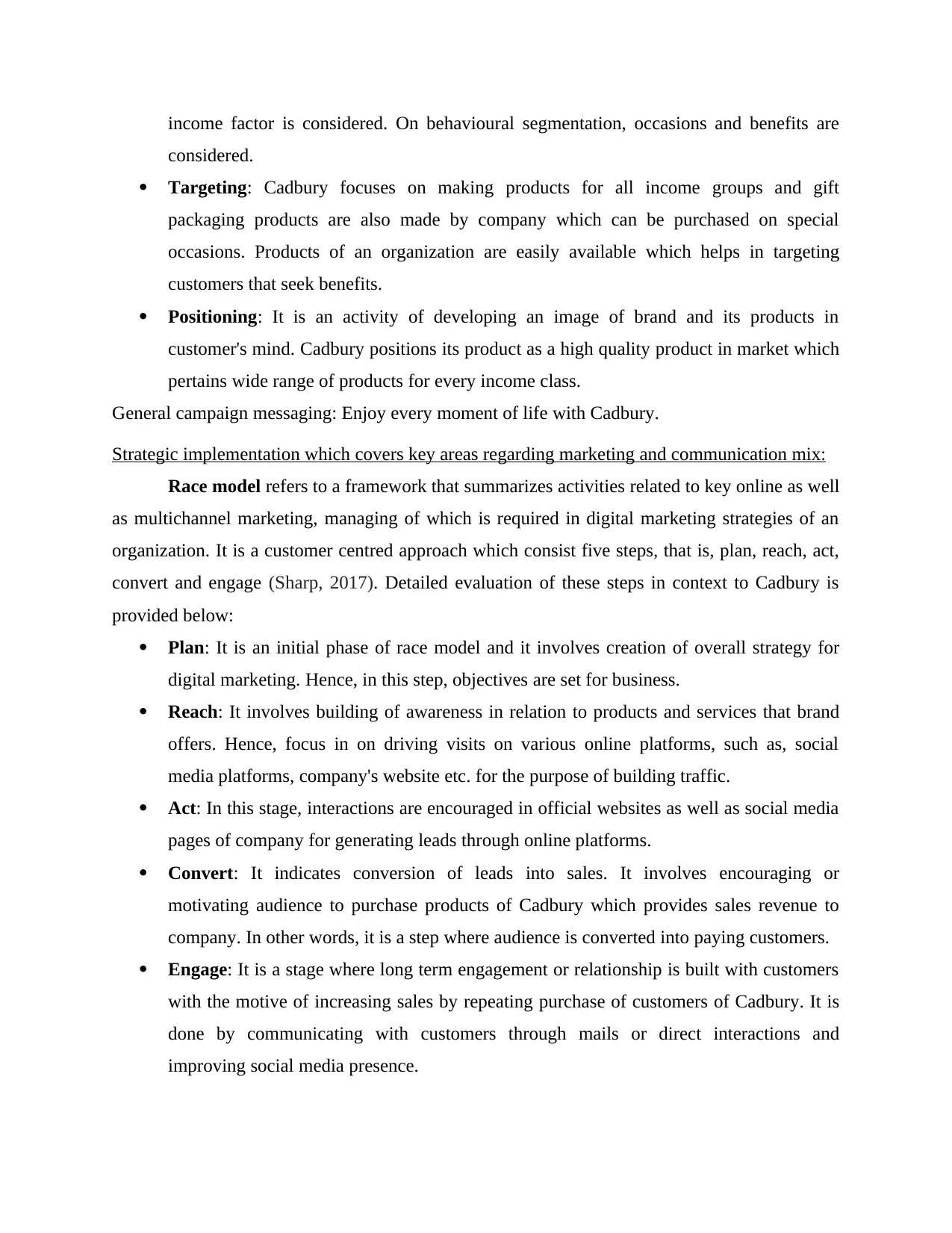
income factor is considered. On behavioural segmentation, occasions and benefits are
considered.
Targeting: Cadbury focuses on making products for all income groups and gift
packaging products are also made by company which can be purchased on special
occasions. Products of an organization are easily available which helps in targeting
customers that seek benefits.
Positioning: It is an activity of developing an image of brand and its products in
customer's mind. Cadbury positions its product as a high quality product in market which
pertains wide range of products for every income class.
General campaign messaging: Enjoy every moment of life with Cadbury.
Strategic implementation which covers key areas regarding marketing and communication mix:
Race model refers to a framework that summarizes activities related to key online as well
as multichannel marketing, managing of which is required in digital marketing strategies of an
organization. It is a customer centred approach which consist five steps, that is, plan, reach, act,
convert and engage (Sharp, 2017). Detailed evaluation of these steps in context to Cadbury is
provided below:
Plan: It is an initial phase of race model and it involves creation of overall strategy for
digital marketing. Hence, in this step, objectives are set for business.
Reach: It involves building of awareness in relation to products and services that brand
offers. Hence, focus in on driving visits on various online platforms, such as, social
media platforms, company's website etc. for the purpose of building traffic.
Act: In this stage, interactions are encouraged in official websites as well as social media
pages of company for generating leads through online platforms.
Convert: It indicates conversion of leads into sales. It involves encouraging or
motivating audience to purchase products of Cadbury which provides sales revenue to
company. In other words, it is a step where audience is converted into paying customers.
Engage: It is a stage where long term engagement or relationship is built with customers
with the motive of increasing sales by repeating purchase of customers of Cadbury. It is
done by communicating with customers through mails or direct interactions and
improving social media presence.
considered.
Targeting: Cadbury focuses on making products for all income groups and gift
packaging products are also made by company which can be purchased on special
occasions. Products of an organization are easily available which helps in targeting
customers that seek benefits.
Positioning: It is an activity of developing an image of brand and its products in
customer's mind. Cadbury positions its product as a high quality product in market which
pertains wide range of products for every income class.
General campaign messaging: Enjoy every moment of life with Cadbury.
Strategic implementation which covers key areas regarding marketing and communication mix:
Race model refers to a framework that summarizes activities related to key online as well
as multichannel marketing, managing of which is required in digital marketing strategies of an
organization. It is a customer centred approach which consist five steps, that is, plan, reach, act,
convert and engage (Sharp, 2017). Detailed evaluation of these steps in context to Cadbury is
provided below:
Plan: It is an initial phase of race model and it involves creation of overall strategy for
digital marketing. Hence, in this step, objectives are set for business.
Reach: It involves building of awareness in relation to products and services that brand
offers. Hence, focus in on driving visits on various online platforms, such as, social
media platforms, company's website etc. for the purpose of building traffic.
Act: In this stage, interactions are encouraged in official websites as well as social media
pages of company for generating leads through online platforms.
Convert: It indicates conversion of leads into sales. It involves encouraging or
motivating audience to purchase products of Cadbury which provides sales revenue to
company. In other words, it is a step where audience is converted into paying customers.
Engage: It is a stage where long term engagement or relationship is built with customers
with the motive of increasing sales by repeating purchase of customers of Cadbury. It is
done by communicating with customers through mails or direct interactions and
improving social media presence.
⊘ This is a preview!⊘
Do you want full access?
Subscribe today to unlock all pages.

Trusted by 1+ million students worldwide
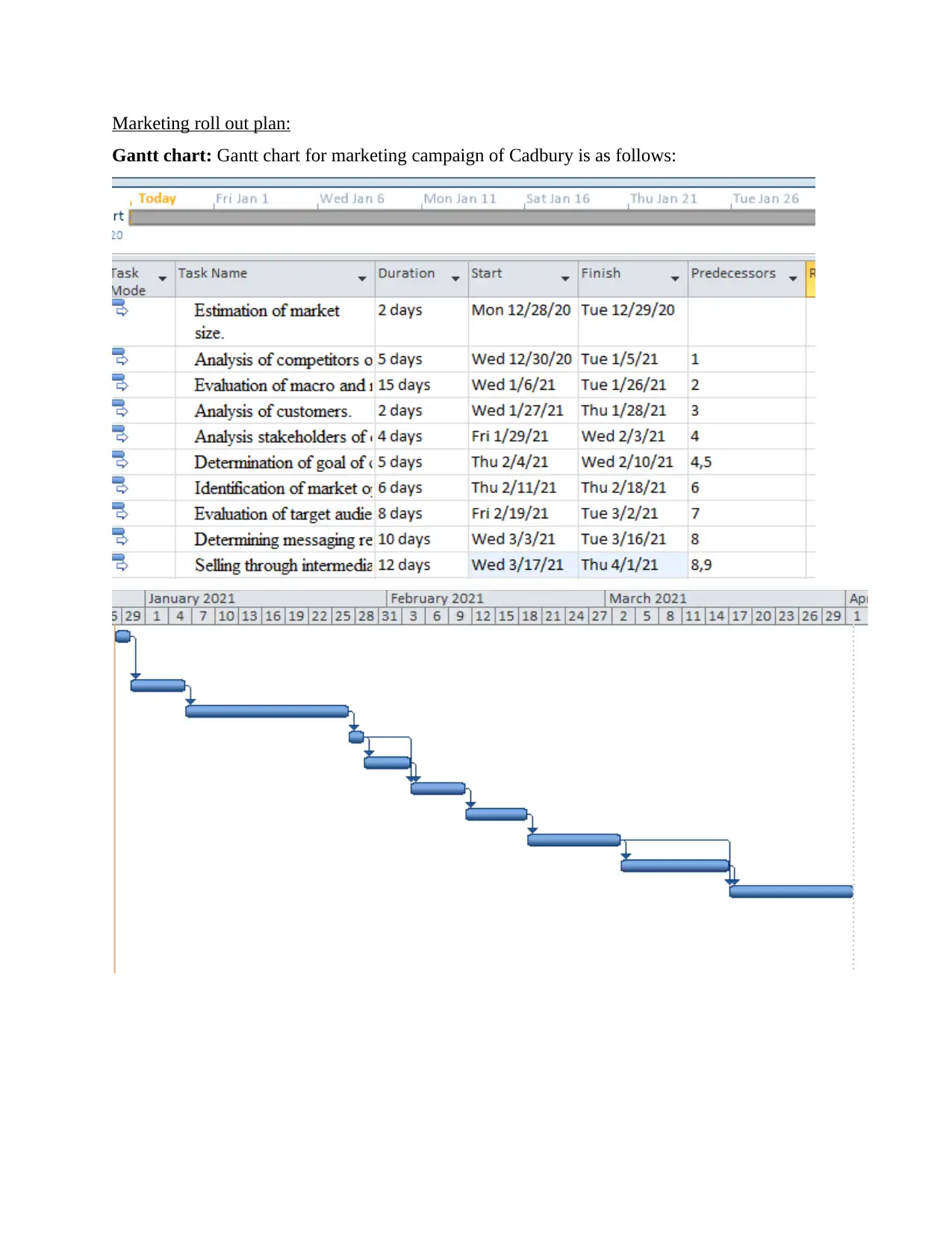
Marketing roll out plan:
Gantt chart: Gantt chart for marketing campaign of Cadbury is as follows:
Gantt chart: Gantt chart for marketing campaign of Cadbury is as follows:
Paraphrase This Document
Need a fresh take? Get an instant paraphrase of this document with our AI Paraphraser
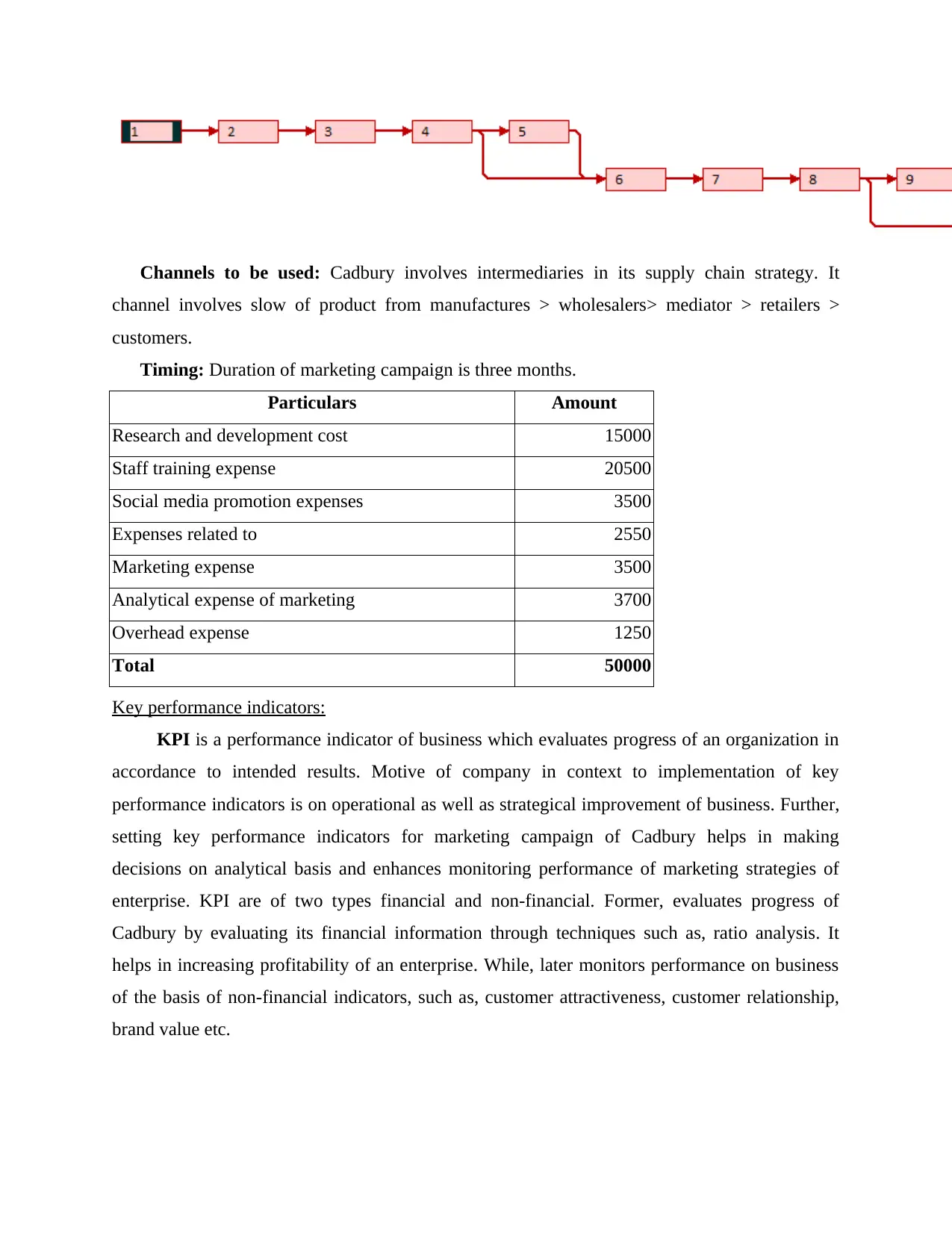
Channels to be used: Cadbury involves intermediaries in its supply chain strategy. It
channel involves slow of product from manufactures > wholesalers> mediator > retailers >
customers.
Timing: Duration of marketing campaign is three months.
Particulars Amount
Research and development cost 15000
Staff training expense 20500
Social media promotion expenses 3500
Expenses related to 2550
Marketing expense 3500
Analytical expense of marketing 3700
Overhead expense 1250
Total 50000
Key performance indicators:
KPI is a performance indicator of business which evaluates progress of an organization in
accordance to intended results. Motive of company in context to implementation of key
performance indicators is on operational as well as strategical improvement of business. Further,
setting key performance indicators for marketing campaign of Cadbury helps in making
decisions on analytical basis and enhances monitoring performance of marketing strategies of
enterprise. KPI are of two types financial and non-financial. Former, evaluates progress of
Cadbury by evaluating its financial information through techniques such as, ratio analysis. It
helps in increasing profitability of an enterprise. While, later monitors performance on business
of the basis of non-financial indicators, such as, customer attractiveness, customer relationship,
brand value etc.
channel involves slow of product from manufactures > wholesalers> mediator > retailers >
customers.
Timing: Duration of marketing campaign is three months.
Particulars Amount
Research and development cost 15000
Staff training expense 20500
Social media promotion expenses 3500
Expenses related to 2550
Marketing expense 3500
Analytical expense of marketing 3700
Overhead expense 1250
Total 50000
Key performance indicators:
KPI is a performance indicator of business which evaluates progress of an organization in
accordance to intended results. Motive of company in context to implementation of key
performance indicators is on operational as well as strategical improvement of business. Further,
setting key performance indicators for marketing campaign of Cadbury helps in making
decisions on analytical basis and enhances monitoring performance of marketing strategies of
enterprise. KPI are of two types financial and non-financial. Former, evaluates progress of
Cadbury by evaluating its financial information through techniques such as, ratio analysis. It
helps in increasing profitability of an enterprise. While, later monitors performance on business
of the basis of non-financial indicators, such as, customer attractiveness, customer relationship,
brand value etc.
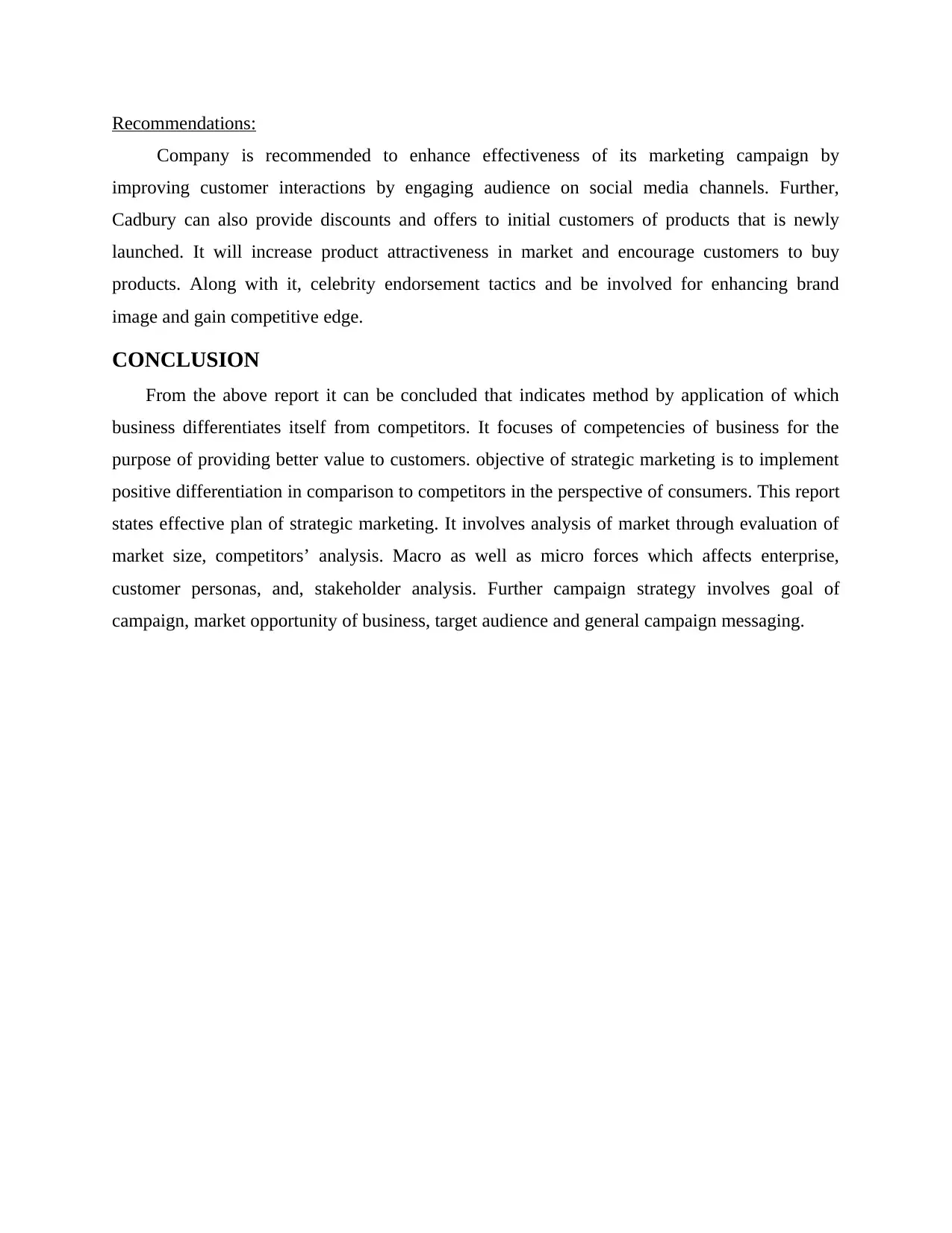
Recommendations:
Company is recommended to enhance effectiveness of its marketing campaign by
improving customer interactions by engaging audience on social media channels. Further,
Cadbury can also provide discounts and offers to initial customers of products that is newly
launched. It will increase product attractiveness in market and encourage customers to buy
products. Along with it, celebrity endorsement tactics and be involved for enhancing brand
image and gain competitive edge.
CONCLUSION
From the above report it can be concluded that indicates method by application of which
business differentiates itself from competitors. It focuses of competencies of business for the
purpose of providing better value to customers. objective of strategic marketing is to implement
positive differentiation in comparison to competitors in the perspective of consumers. This report
states effective plan of strategic marketing. It involves analysis of market through evaluation of
market size, competitors’ analysis. Macro as well as micro forces which affects enterprise,
customer personas, and, stakeholder analysis. Further campaign strategy involves goal of
campaign, market opportunity of business, target audience and general campaign messaging.
Company is recommended to enhance effectiveness of its marketing campaign by
improving customer interactions by engaging audience on social media channels. Further,
Cadbury can also provide discounts and offers to initial customers of products that is newly
launched. It will increase product attractiveness in market and encourage customers to buy
products. Along with it, celebrity endorsement tactics and be involved for enhancing brand
image and gain competitive edge.
CONCLUSION
From the above report it can be concluded that indicates method by application of which
business differentiates itself from competitors. It focuses of competencies of business for the
purpose of providing better value to customers. objective of strategic marketing is to implement
positive differentiation in comparison to competitors in the perspective of consumers. This report
states effective plan of strategic marketing. It involves analysis of market through evaluation of
market size, competitors’ analysis. Macro as well as micro forces which affects enterprise,
customer personas, and, stakeholder analysis. Further campaign strategy involves goal of
campaign, market opportunity of business, target audience and general campaign messaging.
⊘ This is a preview!⊘
Do you want full access?
Subscribe today to unlock all pages.

Trusted by 1+ million students worldwide
1 out of 13
Related Documents
Your All-in-One AI-Powered Toolkit for Academic Success.
+13062052269
info@desklib.com
Available 24*7 on WhatsApp / Email
![[object Object]](/_next/static/media/star-bottom.7253800d.svg)
Unlock your academic potential
Copyright © 2020–2025 A2Z Services. All Rights Reserved. Developed and managed by ZUCOL.





